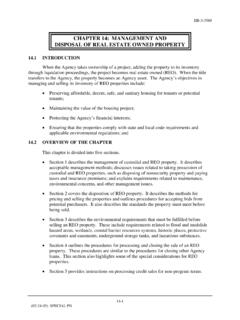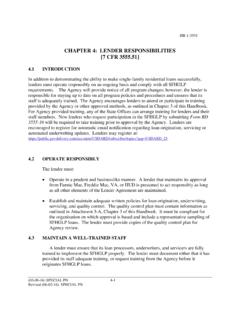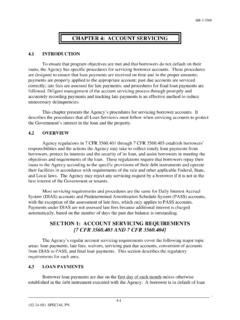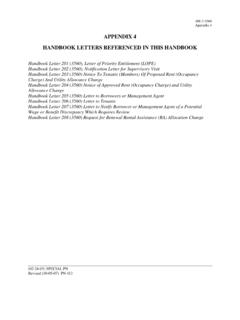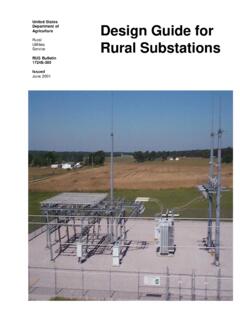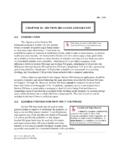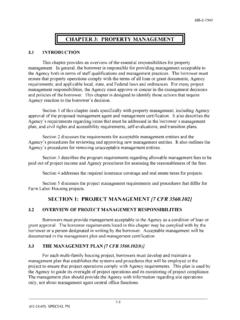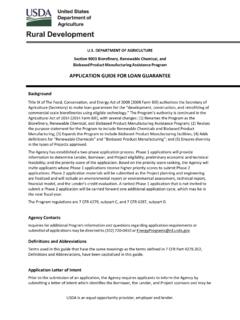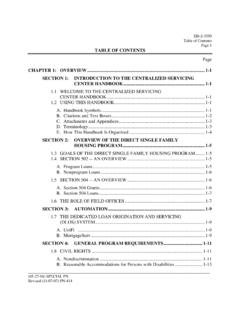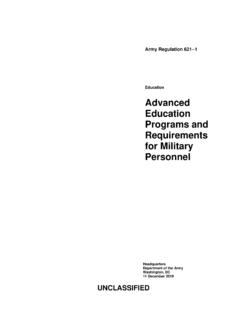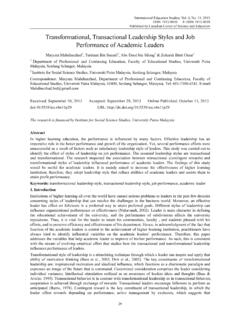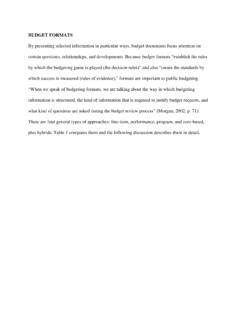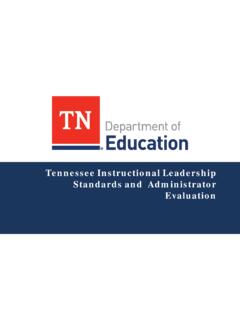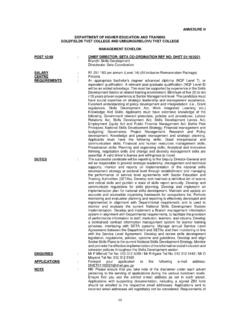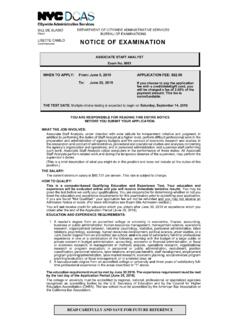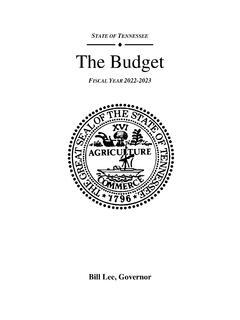Transcription of CHAPTER 3: APPLICATION PROCESSING - USDA Rural …
1 HB-1-3550 INTRODUCTION This CHAPTER describes the process of accepting and managing applications, up to the point that an applicant is selected for PROCESSING . This includes pre-qualifying potential applicants, taking and reviewing applications, and selecting applications for PROCESSING . SECTION 1: PRE-QUALIFICATION OVERVIEW Pre-qualification involves using unverified information to evaluate the likelihood that a potential applicant, someone who is interested in the program but has yet to submit an APPLICATION for assistance, would be program eligible. The results of pre-qualification are not binding and will not hinder the submission of an APPLICATION . A potential applicant with possible obstacles to program eligibility may submit an APPLICATION and a potential applicant who appears program eligible is not guaranteed that a loan will be made. Pre-qualification, which is supported but not required, serves as an opportunity to: Explain the program and the APPLICATION process; Determine the likelihood of eligibility based on income and other factors; Calculate the likely maximum loan amount; and Encourage the early completion of homeownership education for maximum benefit.
2 The Loan Originator should make clear to the potential applicant the purposes of prequalification, that the pre-qualification results are not binding, and pre-qualification is different than the submission of a formal APPLICATION . PROCEDURES FOR PRE-QUALIFICATION The Loan Originator should provide consistent pre-qualification counseling for all potential applicants. Refer to Attachment 3-F for guidance on how to address negative pre-qualification results. Again, the pre-qualification process does not apply to someone who has already submitted an APPLICATION . Submission of an APPLICATION triggers disclosure and official Agency action requirements. _____ 3-1 (01-23-03) SPECIAL PN Revised (02-02-18) PN 508 CHAPTER 3: APPLICATION PROCESSING HB-1-3550 Paragraph Procedures for Pre-Qualification A. Describe the Program During the course of the pre-qualification review, the Loan Originator should provide as much information as possible about how the program works.
3 Although this information will be repeated during the course of the APPLICATION and loan approval process, it is important for the potential applicant to begin to understand how the program works and the steps that will be required to obtain a loan. B. Gathering Basic Eligibility and Financial Information Pre-qualification provides an opportunity to consider whether the potential applicant appears to meet the basic eligibility requirements described in detail in CHAPTER 4. The Loan Originator should enter the information provided by the potential applicant in UniFi as well as their observations on the potential applicant s diversity (race, ethnic group, etc.) if reliable, register the pre-qualification following the instructions in the DLOS Training Manual, and counsel the potential applicant about the following requirements and restrictions. Creditworthiness. The Loan Originator should advise potential applicants about the Agency s credit history standards including the ramifications of delinquency on a federal debt.
4 To aid in this discussion, the Loan Originator may order an in-file credit report provided the potential applicant has signed Form RD 3550-1, Authorization to Release Information. The Loan Originator can also check the Department of the Treasury s Do Not Pay (DNP) portal and check the applicant s social security number against Agency records by using MortgageServ s SSN CROSS REFERENCE softlink key. If the softlink key is not available in the softlink key box, contact your ISSS-POC. Citizen or qualified alien. The Loan Originator can ask potential applicants about their citizenship status and, for qualified aliens, inform them of the documentation that will be required when an APPLICATION is submitted. Identity Information. The Loan Originator should explain to potential applicants the documentation required to verify identity when an APPLICATION is submitted. Requirement to occupy the dwelling. The Loan Originator should explain that the dwelling must serve as a borrower s primary residence, and confirm that the potential applicant intends to use the loan for this purpose.
5 Financial information. The Loan Originator should obtain information from the potential applicant about household members, income, expenses, and debt in order to make a pre-qualification determination of income eligibility and repayment ability. _____ 3-2 HB-1-3550 Paragraph Procedures for Pre-Qualification C. Using UniFi to Calculate the Maximum Loan Amount Once pre-qualification data is entered, UniFi computes the maximum loan amount for which the potential applicant would qualify using standard loan terms, and using any adjustments to the standard terms for which the potential applicant appears to qualify. (See Paragraph B. for a full discussion of adjustments to the standard terms.) When completing the pertinent screens in UniFi, the Loan Originator may want to consider a leveraged loan arrangement if the potential applicant is working with or has already completed an APPLICATION to another funding source prior to making a pre-qualification inquiry with the Agency.
6 The Loan Originator should refer potential applicant to entities offering affordable housing products, such as grants, forgivable loans, deferred payment loans and below-market interest rate loans when such funding sources are available in the local area. In order to receive the benefits of a leveraged loan, the loan must meet the provisions set forth in CHAPTER 10 which provides detailed information about leveraged loans. D. Discussing Pre-Qualification Results The Loan Originator should generate the Eligibility Summary from UniFi to assist in the discussion with the potential applicant. The Loan Originator should always emphasize that the results of the pre-qualification review are unofficial and that the outcome may change when information is verified. For potential applicants in the following 4 categories, additional counseling is appropriate. 1. Over-income Applicants Potential applicants with household incomes above the low-income limit should be informed about options available for those with moderate-income (assumed loan, purchase of a REO property, a Guaranteed Rural Housing loan, and other credit).
7 2. Low Estimated Maximum Loan Amounts If the loan amount for which the potential applicant appears to qualify is not sufficient to purchase a modest, decent, safe, and sanitary house in the area, the Loan Originator should counsel the potential applicant about the need for additional resources, such as other sources of subsidized funds, increased household income, reduced household debt, and the possibility of adding additional parties or a co-signer to the note. See Paragraph for a detailed discussion of other considerations related to maximum loan amounts. _____ 3-3 (01-23-03) SPECIAL PN Revised (02-02-18) PN 508 Pre-Qualification Review Regardless of the outcome of the pre-qualification review, all potential applicants must be offered an opportunity to complete an APPLICATION . HB-1-3550 Paragraph Procedures for Pre-Qualification 3. Candidates for Financing with Private Credit If a potential applicant s credit history, income ( they appear to be above the very low-income limit), assets, and lack of apparent need for payment assistance indicate that they should be able to qualify for a GRH loan or private financing, the Loan Originator should ask whether an attempt to obtain such financing has been made.
8 If not, potential applicants should be informed that they should attempt to obtain other credit. 4. Unacceptable Credit and/or Lack Repayment Ability If a potential applicant s credit appears unacceptable based on an in-file credit report or from information supplied by the potential applicant; or it appears the potential applicant lacks repayment ability for a loan, the Loan Originator should counsel the potential applicant. If the pre-qualification was not conducted face-to-face or over the telephone, the Loan Originator should use Handbook Letter 19 (3550), Pre-qualification Review, as a way to prompt the opportunity to counsel the potential applicant in ways to correct these problems. The Loan Originator may encourage the potential applicant to seek credit counseling or a homeownership education course but should NEVER discourage the potential applicant from submitting an APPLICATION . _____ 3-4 HB-1-3550 SECTION 2: HOMEOWNER education HOMEOWNER education REQUIREMENT [7 CFR (i)] The Agency requires applicants who are first-time homebuyers complete homeowner education training as early in the APPLICATION process as possible since the training will prepare them for shopping, buying, financing, and owning a home.
9 While the training should be completed by the applicant prior to them entering into a contract to purchase or construct a home, the applicant should be encouraged to take the training as soon as they express an interest in homeownership ( when they call inquiring about the program or apply for a loan) for maximum benefit. A. State Director Assessment of Homeowner education [7 CFR ] The State Director will make an assessment by area of the availability of certified homeownership education providers in their respective states. A list of providers will be maintained by the State Office, including the reasonable costs, if any, to the participant. The order of preference for homeownership education formats is as follows: Classroom, one-on-one counseling, or interactive video conference. Interactive home-study or interactive telephone counseling of at least four hours duration. Online counseling. A lower preference homeownership education format may be used when a higher preference format is not reasonably available in the local area, which is determined by factors such as distance, travel time, geographic obstacles, and cost.
10 In order to be included on the list, the provider must have a certificate of completion process and homeownership education counselors that are certified by any of the following: The Department of Housing and Urban Development (HUD); NeighborWorks America (NWA); The National Federation of Housing Counselors (NFHC); National American Indian Housing Council (NAIHC); or The State Housing Finance Agency or other qualified organization approved by the State Director. _____ 3-5 (01-23-03) SPECIAL PN Revised (02-02-18) PN 508 HB-1-3550 Paragraph Homeowner education Requirement In addition, the State Director may include homeowner education provided by USDA Cooperative Extension System staff. Online homeownership education courses offered and accessible on a national, non-state specific basis, will be reviewed and approved by the National Office. This is not intended to endorse a particular online course but to have a process by which these types of online courses will be evaluated in a uniform manner for usage by all states.
![CHAPTER 14: FUNDING [Official Agency Use Only]](/cache/preview/5/1/5/b/5/3/5/c/thumb-515b535cec62fd2bb25fbb788ef1c7a2.jpg)
